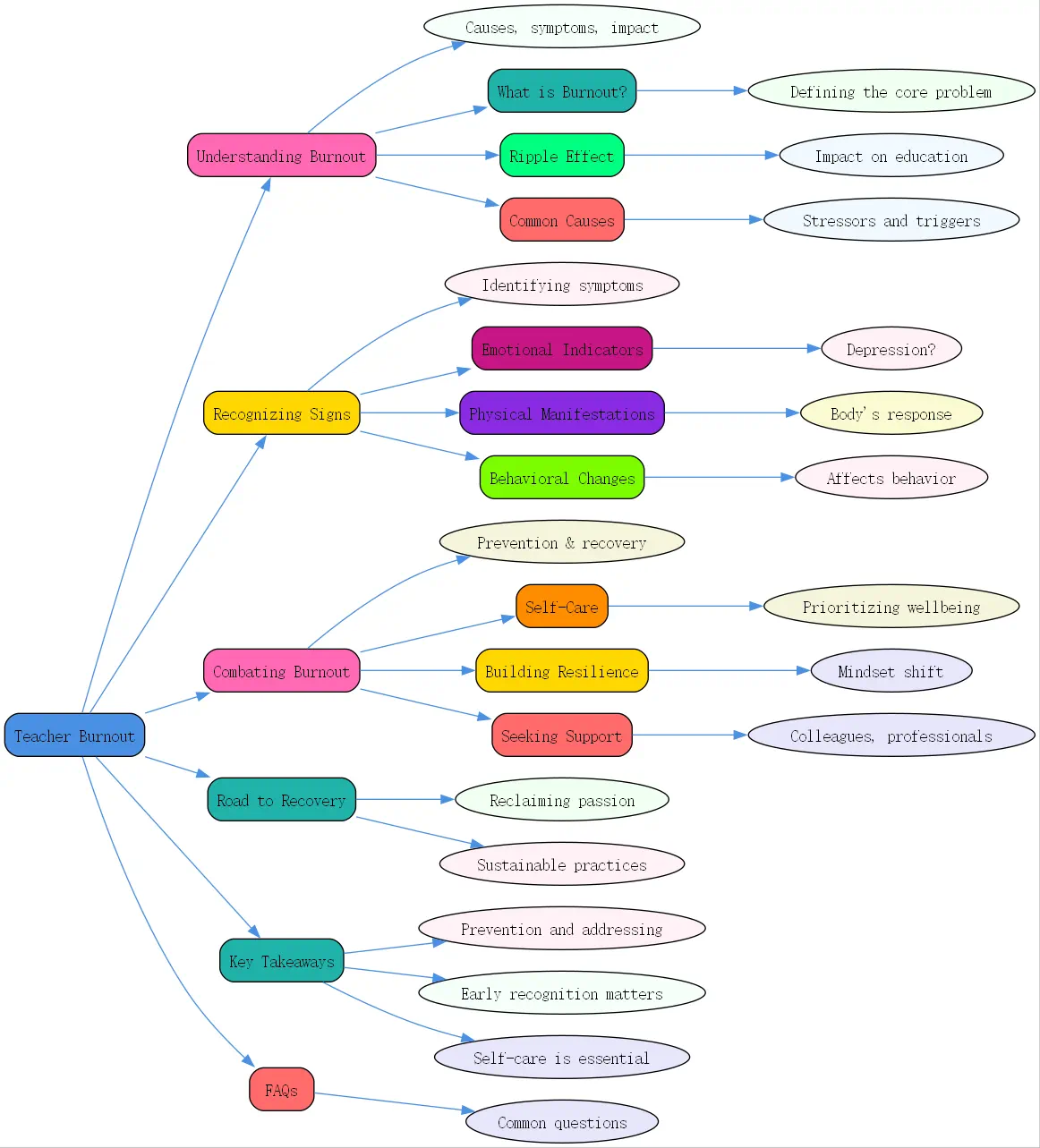Understanding Teacher Burnout: Causes, Symptoms, and Impact

Teaching has always been a demanding profession, but in recent years, the challenges have intensified dramatically. The increasing pressures of standardized testing, administrative demands, and challenging classroom behaviors have created the perfect storm for teacher burnout. This phenomenon isn’t just affecting individual educators—it’s reshaping our entire educational landscape.
What is Teacher Burnout? Defining the Core Problem
Teacher burnout represents far more than just feeling tired after a long week. It’s a state of complete emotional, physical, and mental exhaustion caused by prolonged or excessive stress in the teaching environment. Unlike everyday stress, which might come and go, burnout develops gradually as enthusiasm gives way to fatigue, cynicism replaces optimism, and effectiveness diminishes despite increased effort.
When teachers experience burnout, they find themselves emotionally drained, detached from their students, and questioning their competence and the value of their work. This condition goes beyond normal tiredness—it’s a chronic state where recovery doesn’t happen after a weekend of rest or even during school breaks.
What makes teacher burnout particularly concerning is how it differs from regular stress. While stress typically involves feeling overwhelmed with too many responsibilities, burnout manifests as feeling empty, devoid of motivation, and beyond caring. It’s the difference between drowning in work versus feeling there’s no point in swimming anymore.
The Ripple Effect: How Teacher Burnout Impacts Education
The consequences of teacher burnout extend far beyond the individual educator. When teachers lose their enthusiasm and engagement, students immediately notice the difference. Lessons become mechanical rather than inspiring, and the vibrant learning environment that once characterized a classroom fades away.
Research consistently shows that student achievement directly correlates with teacher engagement. When educators experience burnout, their reduced capacity for creative teaching and emotional investment in students results in measurable declines in student performance and motivation. The emotional connection that drives effective learning becomes compromised.
Additionally, schools face significant operational challenges as teacher burnout leads to increased absenteeism and higher turnover rates. Districts find themselves in a costly cycle of recruiting and training new teachers while losing the invaluable experience and institutional knowledge of veteran educators. The financial and educational costs of this cycle are substantial and often underestimated.
Identifying the Culprits: Common Causes of Teacher Stress and Burnout
Understanding what triggers teacher stress burnout is essential for both prevention and recovery. The most frequently cited cause is the overwhelming workload and extraordinarily long hours that extend well beyond the school day. Teachers often spend evenings and weekends grading papers, planning lessons, and completing administrative paperwork, creating a work-life imbalance that’s simply unsustainable.
Another significant factor is the chronic lack of resources and support. Many teachers routinely spend their own money on classroom supplies and feel unsupported by administration when facing difficult challenges. This sense of isolation amplifies stress and accelerates burnout.
Managing challenging student behaviors represents another major stressor. Today’s classrooms often include students with diverse needs and varying degrees of behavioral challenges. Without adequate training and support in behavior management, teachers can quickly become overwhelmed and emotionally exhausted.
Administrative pressures and the emphasis on standardized testing create additional layers of stress. Many educators feel they’re teaching to tests rather than developing well-rounded students, creating a fundamental conflict with their educational philosophy and vocational calling.
Recognizing the Signs: Symptoms of Teacher Burnout
The road to recovery begins with recognition. Understanding the warning signs of teacher burnout allows for earlier intervention and more effective treatment strategies.
Emotional Indicators: Are You Experiencing Teacher Burnout Depression?
Teacher burnout depression often manifests first in emotional changes that might seem subtle initially but grow more pronounced over time. Many teachers report increased irritability and frustration, finding themselves snapping at students or colleagues over minor issues that wouldn’t have bothered them previously. This emotional dysregulation can be particularly distressing for educators who pride themselves on patience and understanding.
Feelings of hopelessness and helplessness represent another significant warning sign. Teachers may begin to feel their efforts don’t matter, that nothing they do makes a difference, or that the educational system is too broken to improve. This sense of futility can lead to clinical depression, requiring professional intervention. For those experiencing severe symptoms, specialized depression recovery centers offer comprehensive treatment approaches tailored for educators.
Perhaps most troubling is the gradual loss of motivation and enthusiasm for teaching. When educators who once bounced into their classrooms filled with excitement now drag themselves to work with dread, burnout has likely taken hold. This diminished passion not only affects teacher wellbeing but dramatically impacts student engagement and learning outcomes.
Physical Manifestations: The Body’s Response to Teacher Stress Burnout


Our bodies often signal distress before our minds fully recognize it. For teachers experiencing burnout, chronic fatigue and exhaustion become constant companions. This isn’t ordinary tiredness that resolves with a good night’s sleep—it’s a bone-deep exhaustion that persists regardless of rest. Many teachers describe feeling physically drained even after weekends or breaks.
Sleep disturbances frequently accompany teacher stress burnout, creating a vicious cycle. Educators may struggle with insomnia as racing thoughts about work prevent relaxation, or they might experience hypersomnia, sleeping excessively yet never feeling rested. Both patterns further deplete energy resources and cognitive function.
Changes in appetite and weight—either increases or decreases—often accompany burnout as stress hormones disrupt normal metabolic processes. Some teachers find themselves stress-eating for comfort, while others lose interest in food entirely. These physical changes serve as visible manifestations of the internal distress burnout creates.
Behavioral Changes: How Burnout Affects a Burnout Teacher
The behavioral shifts that accompany burnout can significantly impact professional effectiveness and personal relationships. Many burnout teachers begin withdrawing from colleagues and social activities, avoiding the staff lounge, declining invitations to after-school events, or reducing communication with fellow educators. This isolation removes crucial support systems precisely when they’re most needed.
Increased cynicism and negativity represent another common behavioral change. Teachers who once saw possibilities and potential in every student may start making dismissive comments, expecting the worst outcomes, or viewing new initiatives with automatic skepticism. This pessimistic outlook becomes self-reinforcing and challenging to overcome.
Perhaps most concerning for educational outcomes is the decreased job performance and productivity that inevitably accompanies burnout. Even the most dedicated educators struggle to maintain their previous standards when emotionally and physically depleted. Lesson planning becomes less creative, feedback on student work less thorough, and classroom management less consistent—all directly impacting student learning.

Combating Teacher Burnout: Strategies for Prevention and Recovery
While teacher burnout presents serious challenges, effective strategies exist for both prevention and recovery. Implementing these approaches can help educators reclaim their professional passion and personal wellbeing.
Self-Care is Key: Prioritizing Well-being to Avoid Burnout
In the teaching profession, where giving to others forms the core of daily work, self-care often falls to the bottom of the priority list. However, practicing consistent self-care represents the foundation of burnout prevention and recovery. Mindfulness and relaxation techniques offer powerful tools for managing stress before it escalates to burnout. Simple practices like deep breathing exercises between classes, brief meditation during lunch breaks, or mindful walking can interrupt stress cycles before they intensify.
Physical wellbeing plays an equally crucial role in burnout prevention. Regular exercise, balanced nutrition, and adequate sleep form the trifecta of resilience against stress. Research consistently shows that physical activity—even in short bursts—reduces stress hormones and increases endorphins, creating natural protection against burnout. At depression recovery centers, these holistic approaches are integrated with therapeutic interventions to support complete recovery.
Perhaps most challenging—yet most essential—for teachers is establishing clear boundaries around workload and availability. Learning to say “”no”” to extra committees, voluntary responsibilities, and work that extends beyond contract hours isn’t selfish; it’s necessary for sustainability. Many burnout teachers report that their condition developed gradually as they continuously added responsibilities without removing others, creating an unsustainable workload that eventually collapsed.
Building Resilience: Mindset Makeover for Stress Management
While we can’t eliminate all stressors from teaching, we can transform how we perceive and respond to them. Cognitive reframing—learning to view stressful situations as challenges rather than threats—builds psychological resilience over time. This perspective shift doesn’t diminish the reality of difficulties but changes our relationship to them, activating problem-solving rather than fight-or-flight responses.
Practicing optimism and gratitude, even amid challenges, creates protective psychological factors against burnout. BrainTalking research indicates that educators who maintain appreciation for small victories and positive moments demonstrate greater resilience against teacher burnout depression. Simple practices like keeping a teaching victory journal or acknowledging one positive student interaction daily can gradually reshape neural pathways toward greater resilience.
Focusing on what you can control represents another powerful mindset shift. Teachers face numerous systemic issues beyond their influence—budget constraints, policy decisions, social factors affecting students. Directing energy toward areas where personal agency exists—classroom environment, teaching methods, professional relationships—preserves valuable emotional resources and creates meaningful impact within realistic parameters.
Seeking Support: Connecting with Colleagues and Professionals
No teacher should face burnout alone. Building a strong support network of colleagues who understand the unique challenges of education provides both emotional sustenance and practical assistance. Creating formal or informal teacher support groups, whether in-person or virtual, offers safe spaces to share experiences, strategies, and encouragement without judgment.
Open communication with administrators represents another crucial support channel. While challenging in some school cultures, honest conversations about workload, resource needs, and burnout concerns can lead to collaborative solutions that benefit both teachers and students. Administrators who understand teacher burnout often implement systemic changes that prevent widespread staff depletion.
For teachers experiencing significant burnout symptoms, professional support from therapists or counselors provides essential intervention. Many depression recovery centers offer programs specifically designed for educators experiencing burnout, combining evidence-based therapeutic approaches with practical strategies for classroom management and stress reduction. Seeking help isn’t a sign of weakness but a professional commitment to restoring effectiveness and wellbeing.
The Road to Recovery: Reclaiming Your Teaching Passion
Recovery from teacher burnout requires patience and intentionality. Small, consistent steps toward wellbeing gradually rebuild emotional reserves and professional engagement. Many educators find that reconnecting with their original teaching purpose—the reasons they entered education initially—helps reignite passion that burnout had diminished.
Developing sustainable teaching practices represents another essential recovery component. This might involve reimagining grading systems to reduce paperwork burden, implementing classroom management approaches that require less emotional labor, or creating lesson plan templates that streamline preparation. The goal isn’t cutting corners but creating sustainable excellence.
Finally, celebrating progress—no matter how incremental—reinforces recovery momentum. Each small improvement deserves acknowledgment: having energy after school, feeling genuine excitement about a lesson, connecting emotionally with students again. These victories, while perhaps invisible to others, mark important milestones on the journey back from burnout.
Key Takeaways for Preventing and Addressing Teacher Burnout
- Teacher burnout results from chronic stress and manifests in emotional, physical, and behavioral symptoms
- Early recognition of burnout signs allows for more effective intervention
- Self-care isn’t selfish—it’s essential for sustainable teaching practice
- Mindset shifts and cognitive reframing build resilience against stress
- Building support networks provides both emotional sustenance and practical solutions
- Professional help may be necessary when burnout progresses to depression
- Recovery happens gradually through consistent, intentional wellbeing practices
FAQs About Teacher Burnout
Q: Is teacher burnout considered a medical condition?
A: While teacher burnout itself isn’t classified as a medical diagnosis, it’s recognized as a serious occupational phenomenon that can lead to diagnosable conditions like depression, anxiety disorders, and physical health problems. The World Health Organization acknowledges burnout as an occupational syndrome characterized by exhaustion, cynicism, and reduced professional efficacy. When burnout progresses to clinical depression or anxiety, medical intervention becomes appropriate and necessary. Many educators benefit from comprehensive treatment at specialized depression recovery centers that address both psychological and physical symptoms.
Q: How long does it take to recover from teacher burnout?
A: Recovery timelines vary significantly depending on burnout severity, available support systems, and individual factors. Mild burnout caught early might resolve within a few months with appropriate interventions and lifestyle changes. More severe cases, especially those involving clinical depression, may require 6-12 months or longer for full recovery. The recovery process isn’t linear—teachers often experience improvements followed by setbacks before achieving sustainable wellbeing. The most important factor is implementing consistent self-care practices and making necessary changes to workload and boundaries, allowing gradual restoration of emotional and physical resources.




